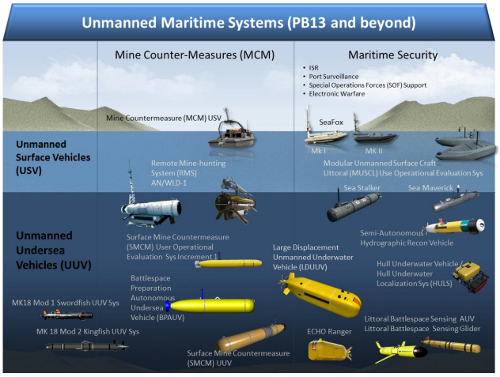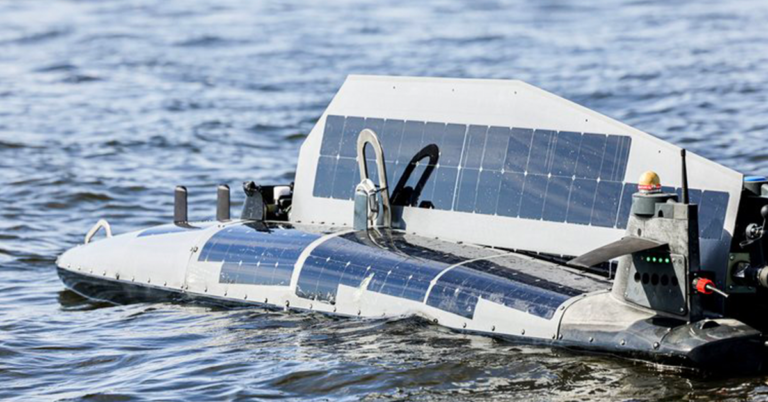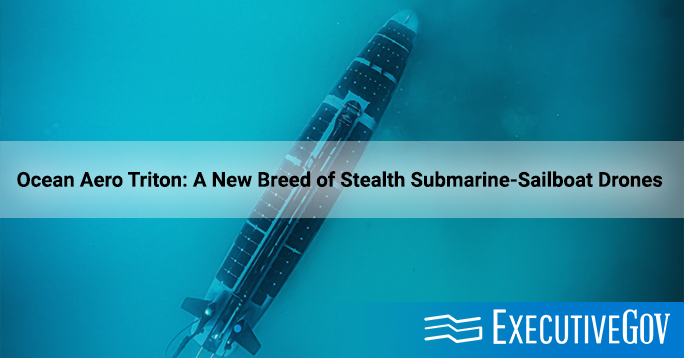Become a member of the Potomac Officers Club to get a front seat to current events in the government contracting landscape by clicking here!
In the ever-evolving landscape of naval warfare, a new game-changing innovation has emerged — stealth submarine sailboat drones. These highly advanced vessels are revolutionizing the way naval operations are conducted. The power of submarines, sailboats, and unmanned aerial vehicles (UAVs) are combined into a single deadly package.
These UAVs have the ability to operate undetected beneath the ocean’s surface, thus reshaping the future of naval warfare. Imagine a fleet of silent and invisible vessels, capable of launching covert attacks or gathering critical intelligence without being detected.
The submersible vessels can navigate coastal waters, slip through narrow channels, and even blend in with civilian vessels. Formidable forces such as these come with advanced surveillance technology and provide real-time data to military command centers. At the same time, they help in enhancing situational awareness and enabling strategic decision-making.
Table of Contents
Evolution of naval warfare technology

Naval warfare has come a long way since the days of wooden ships and cannons. Over the centuries, technological advancements have transformed naval operations, enabling more effective strategies and tactics.
From the 19th century steam-powered ships to the 20th century development of aircraft carriers and guided missile systems, naval forces have continually adapted to new challenges and embraced emerging technologies.
In recent decades, the focus has shifted towards unmanned systems and autonomous technologies. The integration of artificial intelligence, sensors, and communication systems paved the way for the development of stealth submarine sailboat drones.
These technologically advanced vessels combine the stealth capabilities of submarines, the maneuverability of sailboats, and the versatility of UAVs, creating a formidable force that can operate in various environments. Not only that — they come in sizes with unique capabilities!
To know more about the latest in cutting-edge technology for the U.S. military, reserve a slot at Potomac Officers Club’s 10th Annual Defense Research and Development Summit which is happening on January 31, 2024.
Applications of stealth submarine sailboat drones in naval warfare

The concept of stealth submarine sailboat drones originated from the need for a more covert and versatile naval asset. Traditional submarines are powerful but lack the ability to blend in with civilian vessels or operate in shallow coastal waters.
Sailboats, on the other hand, are nimble but lack the stealth and firepower of submarines. By combining the best attributes of both, naval engineers have created a new breed of vessel.
The applications of stealth submarine sailboat drones in naval warfare are vast and varied such as the following:
- Streamlined for stealth design: The design minimizes acoustic and electromagnetic signatures, making them difficult to detect even by the most advanced surveillance technologies. With their sail propulsion system, it can conserve energy and reduce noise emissions.
- Intelligence gathering: These drones can be deployed to collect valuable information on enemy activities, such as troop movements, naval deployments, and potential threats. Operating covertly and providing on the spot information enhances the effectiveness of intelligence operations.
- Precision strikes: They can be armed with guided missiles or torpedoes, to launch devastating attacks on enemy ships, ports, or infrastructure. With stealth capabilities, they can approach their targets undetected, increasing the element of surprise and reducing the risk of counterattacks. This makes them an ideal weapon for conducting covert operations and asymmetrical warfare.
- Mine countermeasure tool: These drones can be used for mine countermeasures, underwater surveillance, and search and rescue operations. They can detect and neutralize underwater mines, monitor maritime borders for illegal activities, and assist in the rescue of stranded or distressed vessels.
Advantages of stealth submarine sailboat drones

Stealth submarine sailboat drones offer several key advantages over traditional naval assets.
Ability to operate undetected: Allows for gathering valuable intelligence without raising suspicion. They can discreetly monitor enemy activities, track naval movements, and provide actual data to military command centers.
This enhanced situational awareness enables naval forces to make informed decisions and respond effectively to changing circumstances.
Versatility: Allows performing a wide range of missions such as reconnaissance and surveillance missions, and deployment of special forces, They can even accurately strike enemy targets.
Their ability to navigate shallow waters and blend in with civilian vessels gives them a significant advantage in coastal regions, where traditional naval assets may be restricted or easily detected.
Cost-effective and reduced risks: Without the need for a human crew, stealth submarine sailboat drones eliminate the risks associated with human error, fatigue, and potential casualties. They can operate autonomously for extended periods, reducing the need for frequent resupply and maintenance.
This makes them a cost-effective solution for naval forces looking to maximize their capabilities while minimizing risks. It makes them keep a huge portion from the FY military budget.
Join key figures from the government contracting industry in the upcoming Challenges and Best Practices to Achieving Audit Readiness in the DoD Forum. These experts will provide an insight on how the Department of Defense and other government agencies spend their budget.
Challenges and limitations of stealth submarine sailboat drones

While stealth submarine sailboat drones offer numerous advantages, they also face certain limitations. Although not all, some challenges found in other drones of this genre are the following:
- Maintaining communication and control: Radio signals are greatly attenuated underwater, limiting the range and reliability of remote control systems. These drones must rely on pre-programmed instructions or independent decision-making algorithms, which may not always be able to adapt to dynamic situations.
- Endurance: Unlike traditional submarines, which can operate for months and carry a significant amount of supplies and weapons, stealth submarine sailboat drones have limited endurance.
- Payload capacity: They require regular resupply and maintenance, which can be logistically challenging in remote or hostile environments.Their small size limits the size and range of weapons they can carry, reducing their offensive capabilities.
What are the current developments and initiatives in stealth submarine sailboat drone technology?

As technologies continue to advance, the future of naval warfare with stealth submarine sailboat drones looks promising. Ongoing research and development efforts aim to overcome the existing limitations and enhance the capabilities of these drones.
Improved communication systems, increased endurance, and higher payload capacity are among the areas of focus. Furthermore, the integration of artificial intelligence and machine learning algorithms will enable these drones to adapt to changing conditions and make autonomous decisions in real-time.
This will enhance their effectiveness in complex and dynamic environments, allowing them to operate with minimal human intervention. Additionally, advancements in stealth mechanics will further reduce their detectability, making them even more elusive and effective on the battlefield.
What is the future of stealth submarine sailboat drones?
As the world’s naval forces increasingly invest in autonomous technologies, stealth submarine sailboat drones are set to become an integral part of future naval operations. Their ability to go where traditional vessels cannot, coupled with their versatility and effectiveness, gives them a significant advantage on the battlefield.
From intelligence gathering to precise strikes, these futuristic vessels are changing the game, ensuring that the future of sea warfare is anything but predictable. The introduction of stealth submarine sailboat drones has significant implications for global security.
While stealthy sailboat subs like the Ocean Aero Triton drones becoming more prevalent, other naval vessels may become less relevant in certain scenarios. This would soon raise concerns about arms control and arms agreement efforts.
The relatively low cost and accessibility of these drones could lead to an increase in their use by both state and non-state actors. This could eventually escalate regional tensions and potentially lead to an arms race in self-governing naval technologies in the near future.





